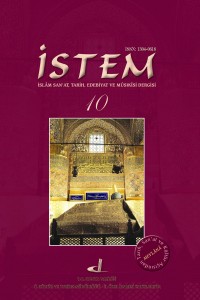Abstract
Mevlânâ Celâleddîn-i Rumî (604/1207 - 672/1273), musikî ilmi ve sanatını eserlerinde ve yaşayışında daima ön plâna çıkaran bir anlayış sergilemiş olup, müzik aletleri ve müziğin insan üzerindeki etkileri dolayısı ile tasavvuf sırlarının açıklanmasında da bu konudan faydalanma yoluna gitmiştir. Mesnevî’de “ney” sazını esas alıp onun üzerinden misallerle tasavvuf terbiyesini ve sırlarını anlatmaya çalışmış olup, Divân-ı Kebîr ve Rubâiler adlı eserlerinde ise daha çok “rebap” sazı üzerinden misallerle aynı konuya yaklaşmıştır. Buradan hareketle Tasavvuf Musikîsin’de çok eski dönemlerden beri kullanılmakta olan, fakat günümüzde aynı ilgiyi pek fazla göremeyen rebaba Mevlânâ tarafından ne kadar çok önem verildiğini, bu saza karşı olanlara da ne kadar çok sitemler edildiğini eserleri ve yaşayışını anlatan menkıbelerden alıntılarla anlatılmıştır. Ayrıca, Mevlânâ’nın rebap sazını yapısında düzenlemeler yapacak kadar tanıması ve bizzat kullanması da makalede konu edilmiştir
References
- » Ahmet Eflâkî Dede, Ariflerin Menkıbeleri , (çev: Tahsin Yazıcı), M.E.B. Yay. C: I-II, 1964 - İst.
- » Can Şefik, Hz. Mevlânâ’nın Rubâileri, Kültür Bakanlığı Yayınları, 2001-Ankara.
- » Çağlar M. Ali, “Rebab Hakkında”, Musikî Mecmuası, Yıl: 21, Sayı: 255, s: 9, Şubat 1970 - İst.
- » Değirmençay Veyis, Sultan Veled ve Rebabnâme, ( Atatürk Ünv. Sosyal Bilimler Enstitüsü, Doğu Dilleri ve Edebiyatı Ana Bilim Dalı, Basılmamış Doktora Tezi), 1996 -Erzurum.
- » Dervîşî Muhammed Rızâ, Encyclopaedia of the Musical Instruments of Iran, C: I-II, 2004,2005 - Tehran.
- » Gazimihal Mahmud Ragıp, “Yunus’tan Beri İkiz Kardeşler Musikî ve Şiir”, Şadırvan, C:I, Sayı:7, s:4,5; Mayıs – 1949 -İstanbul.
- » Gölpınarlı Abdülbâki, Mevlânâ Celâleddin, İnkılâp Yay. 1999 - İstanbul.
- » Mevlânâ Celâleddin-i Rûmî, Mevlânâ’nın Rubâileri, (çev:M.Nuri Gençosman),MEB.Yay.1974,İst.
- » ___________, Divân-ı Kebir,(hazırlayan: Abdülbâki Gölpınarlı), Kültür Bak.Yay. I-VII, Ank.2000.
- » ___________, Fîh-i mâfih, (çev: Meliha Ambarcıoğlu), M. Eğ. B. Yay. 1974 - İstanbul.
- » Pakalın M. Zeki, Osmanlı Tarih Deyimleri ve Terimleri Sözlüğü, C: I-II, 1950 , 1954 – İst.
- » Şemseddîn Ahmed Eflâkî El-Arifî, Menâkıbu’l – Arifîn, (Tashîhât ve Talikât: Tahsin Yazıcı), Dünyaî Kitab, 1385 / m. 1965 - Tehran.
- » Tatçı Mustafa, Yunus Emre Divânı, C: II, s: 65, 1990 - Ankara.
- » Usbeck Hedwig, “Türklerde Musiki Aletleri ( Rebab)”, Musikî Mecmuası, Yıl: 21, Sayı: 256, s:25,26, Mart 1970 – İstanbul.
- » Volkan Sabahaddin, “Rebâb”, Musikî Mecmuası, Yıl: 21, Sayı: 254, s: 11, Ocak1970 - İstanbul. ————
- a.g.e. C: III, s: 91, mısra no: 692.
- a.g.e. C: III, s: 91, mısra no: 694.
- a.g.e. C: V, s: 336, mısra no: 4148, 4150.
- a.g.e. C: V, s: 366, mısra no: 4724.
- a.g.e. C: VII, s: 577, mısra no: 7642.
Abstract
Mawlana Jalal al-Din Rumi (604/1207 - 672/1273), had always an unterstanding which considered music and arts in his work and life. He preferred to use the effect of musical instruments and music upon human being in explaining the secrets of sufism. In his “Masnawi”, he has chosen “ney” to explain the mystical education and secrets, by giving examples driven out of “ney”. In his “Diwan-ı Kabir” and “Rubais”, he rather chose to give examples based on “rebap” to explain the same matter. Therefore, in this article, based on his works and relevant passages from the Legends (Manaqibs), it has been explained that how Mawlana, while criticizing those who were against “rebap”, gave importance to it, which had been used in sufi music since very early times, yet today does not have that appreciation. Here, it has been also indicated that Mawlana had a deep acquaintance with “rebap” so much that he was able to reorganize the structure of the instrument, in addition to his playing personally
References
- » Ahmet Eflâkî Dede, Ariflerin Menkıbeleri , (çev: Tahsin Yazıcı), M.E.B. Yay. C: I-II, 1964 - İst.
- » Can Şefik, Hz. Mevlânâ’nın Rubâileri, Kültür Bakanlığı Yayınları, 2001-Ankara.
- » Çağlar M. Ali, “Rebab Hakkında”, Musikî Mecmuası, Yıl: 21, Sayı: 255, s: 9, Şubat 1970 - İst.
- » Değirmençay Veyis, Sultan Veled ve Rebabnâme, ( Atatürk Ünv. Sosyal Bilimler Enstitüsü, Doğu Dilleri ve Edebiyatı Ana Bilim Dalı, Basılmamış Doktora Tezi), 1996 -Erzurum.
- » Dervîşî Muhammed Rızâ, Encyclopaedia of the Musical Instruments of Iran, C: I-II, 2004,2005 - Tehran.
- » Gazimihal Mahmud Ragıp, “Yunus’tan Beri İkiz Kardeşler Musikî ve Şiir”, Şadırvan, C:I, Sayı:7, s:4,5; Mayıs – 1949 -İstanbul.
- » Gölpınarlı Abdülbâki, Mevlânâ Celâleddin, İnkılâp Yay. 1999 - İstanbul.
- » Mevlânâ Celâleddin-i Rûmî, Mevlânâ’nın Rubâileri, (çev:M.Nuri Gençosman),MEB.Yay.1974,İst.
- » ___________, Divân-ı Kebir,(hazırlayan: Abdülbâki Gölpınarlı), Kültür Bak.Yay. I-VII, Ank.2000.
- » ___________, Fîh-i mâfih, (çev: Meliha Ambarcıoğlu), M. Eğ. B. Yay. 1974 - İstanbul.
- » Pakalın M. Zeki, Osmanlı Tarih Deyimleri ve Terimleri Sözlüğü, C: I-II, 1950 , 1954 – İst.
- » Şemseddîn Ahmed Eflâkî El-Arifî, Menâkıbu’l – Arifîn, (Tashîhât ve Talikât: Tahsin Yazıcı), Dünyaî Kitab, 1385 / m. 1965 - Tehran.
- » Tatçı Mustafa, Yunus Emre Divânı, C: II, s: 65, 1990 - Ankara.
- » Usbeck Hedwig, “Türklerde Musiki Aletleri ( Rebab)”, Musikî Mecmuası, Yıl: 21, Sayı: 256, s:25,26, Mart 1970 – İstanbul.
- » Volkan Sabahaddin, “Rebâb”, Musikî Mecmuası, Yıl: 21, Sayı: 254, s: 11, Ocak1970 - İstanbul. ————
- a.g.e. C: III, s: 91, mısra no: 692.
- a.g.e. C: III, s: 91, mısra no: 694.
- a.g.e. C: V, s: 336, mısra no: 4148, 4150.
- a.g.e. C: V, s: 366, mısra no: 4724.
- a.g.e. C: VII, s: 577, mısra no: 7642.
Details
| Other ID | JA67TR59SY |
|---|---|
| Journal Section | Research Articles |
| Authors | |
| Publication Date | December 1, 2007 |
| Submission Date | December 1, 2007 |
| Published in Issue | Year 2007 Issue: 10 |
This work is licensed under a Creative Commons Attribution-NonCommercial 4.0 International License (CC BY NC).


